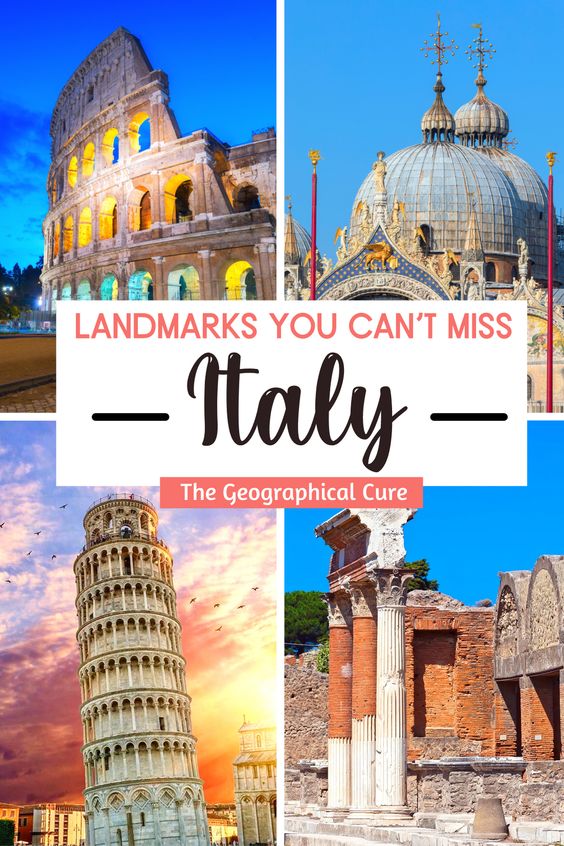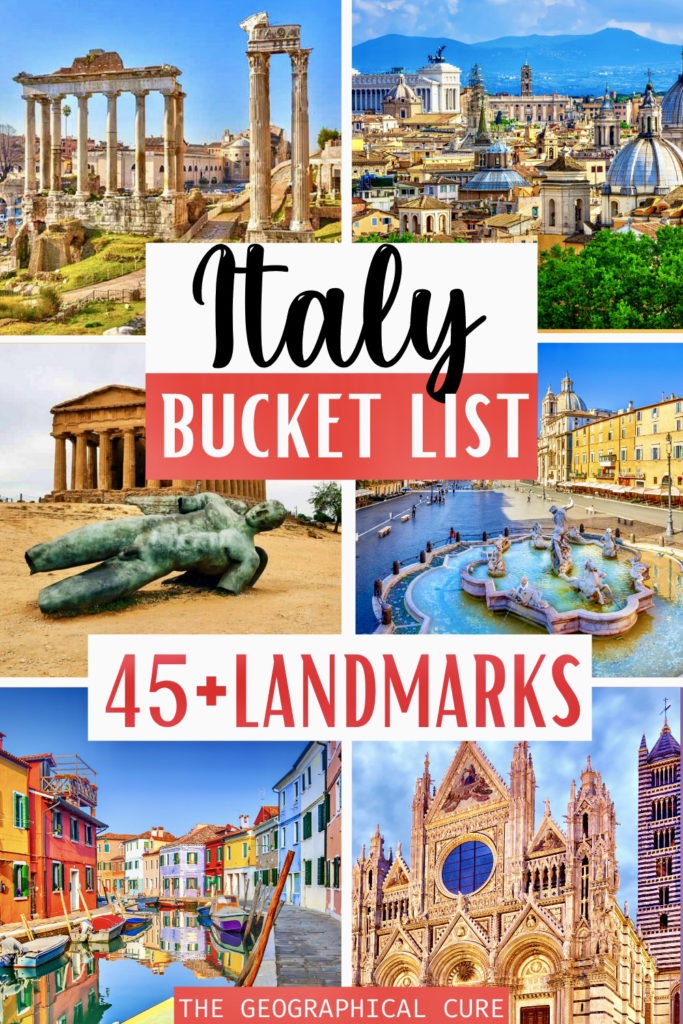Are you planning a trip to Italy and need some destination inspiration? Here’s my guide to 48 must visit landmarks in Italy. These famous Italian landmarks will take your breath away!
Italy is show stoppingly beautiful. The country has heady mix of world famous attractions — stunning cathedrals, ancient Roman ruins, and masterpieces of Roman and Renaissance art.
There are so many amazing things to see and do in Italy. How to choose between the myriad options?
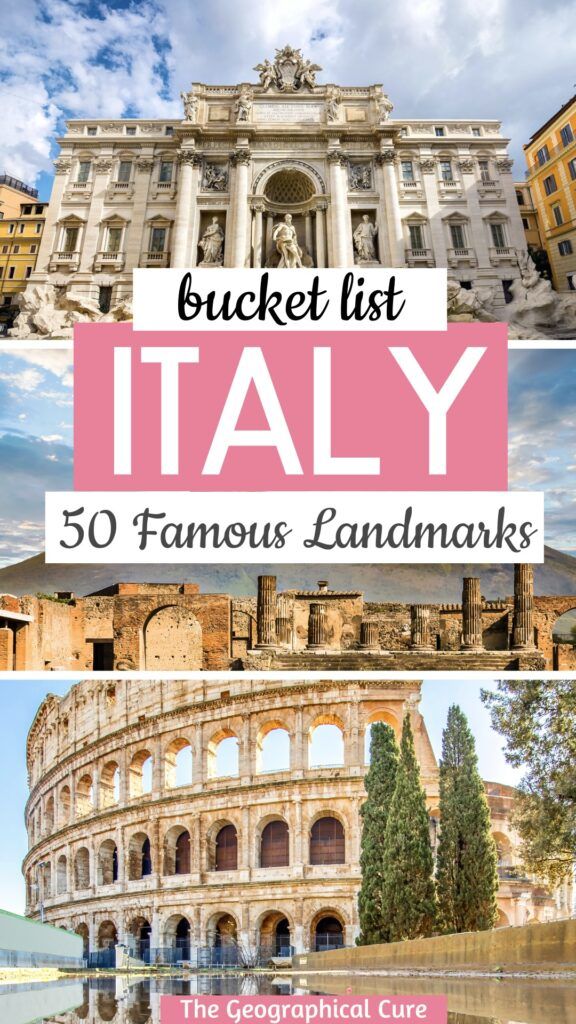
In this guide, I take you on a tour of the 50 most famous historic landmarks in Italy to help you create your Italy bucket list or Italy itinerary.
I’ve grouped these unmissable Italian landmarks by region. As you’d expect, there’s a high concentration in and around Rome and Florence.
Famous Landmarks in Italy
So let’s get down to business and discover the best and most famous landmarks in Italy.
Landmarks In Italy In Rome
1. Roman Forum
The ancient Roman Forum is a must visit landmark in Rome. It’s rectangular valley running from the Arch of Titus to Capitoline Hill. The main road is the Via Sacre. The forum was the beating heart of Rome, the seat of political power, and its stunning central showpiece.
Today, the Roman Forum is mostly a rock strewn ruin that you’ll need to have interpreted by a good guide. Stroll by the Basilica of Constantine, the Temple and House of the Vestal Virgins, the Temple of Venus and Rome, the Basilica of Constantine, and the 3 columns of the Temple of Castor and Pollux.
You’ll also find the ruins of the Temple of Caesar. It was built by Rome’s first emperor, Augustus, after Julius Caesar’s assassination. Inside, in a small apse area, is a mound of stone and dirt covered with coins and flowers. This is the altar holding Caesar’s ashes and marks his grave.
Here’s my complete guide to the monuments of the Roman Forum. Click here for a guided tour of all three imperial sites, which will take approximately 3 hours.
2. Pantheon
Without a doubt, the Pantheon is the best preserved landmark from ancient Rome. The Pantheon was a temple dedicated to all of the gods.
It was originally built by Augustus’ right hand man, Marcus Agrippa, in 27 BC. In 120 AD, the Pantheon was rebuilt by Hadrian. The well-traveled emperor was a true Grecophile.
Hadrian reimagined the Pantheon as an oversized Greek temple — with 40 foot tall Corinthian granite columns from Egypt, a pediment, and portico. It was considered a masterpiece of engineering and mathematical precision.
The Pantheon’s most emblematic feature is its perfect unsupported spherical dome. At the time, it was a major architectural breakthrough.
The dome became the model for Michelangelo’s dome for St. Peter’s Basilica and for Brunelleschi’s dome for Florence Cathedral. At the top is the oculus, or eye, which is the Pantheon’s only source of natural light.
The Pantheon is filled with tombs of important Romans, including famed Renaissance artist Raphael.
Here’s my complete guide to visiting the Pantheon.
The Pantheon used to be free to visit. But as of July 3, 2023, there is a 5 euro fee. To avoid long lines, you can pre-book a ticket on Get Your Guide or Tiqets. Click here for a guided tour of the Pantheon.
3. St. Peter’s Basilica
St. Peter’s Basilica is the most famous church in Christendom. It’s a magnificent Italian landmark in a city that does beautiful churches like no other.
Designed by Bramante, Raphael, and Michelangelo, it’s a true Renaissance masterpiece. The dome of St. Peters, partly designed by Michelangelo, is the tallest in the world.
The basilica is the burial place of St. Peter and past popes and houses the famous Bernini Baldachine altar. The basilica is just packed with statues of popes, saints, and cherubs.
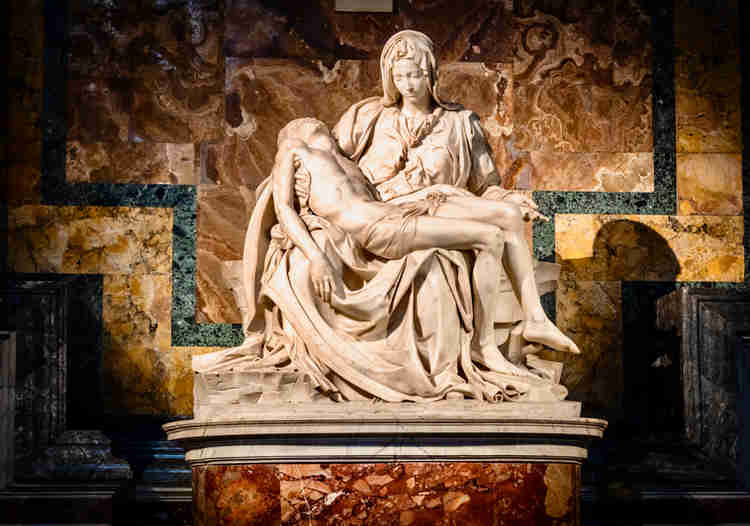
The most famous is behind stained glass, Michelangelo’s tragically beautiful Pieta. St. Peter’s also has one of the greatest collections of the work of Bernini, the greatest artist of the Baroque.
For just € 6, you can climb up a narrow flight of stairs to inspect the dome at close range. There’s also an elevator for € 8. This is where you have the iconic view of St. Peter’s Square and a panoramic view of Rome.
Here’s my complete guide to St. Peter’s Basilica. You can take a guided tour of St. Peters. You can also visit the underground grottos on a guided tour.
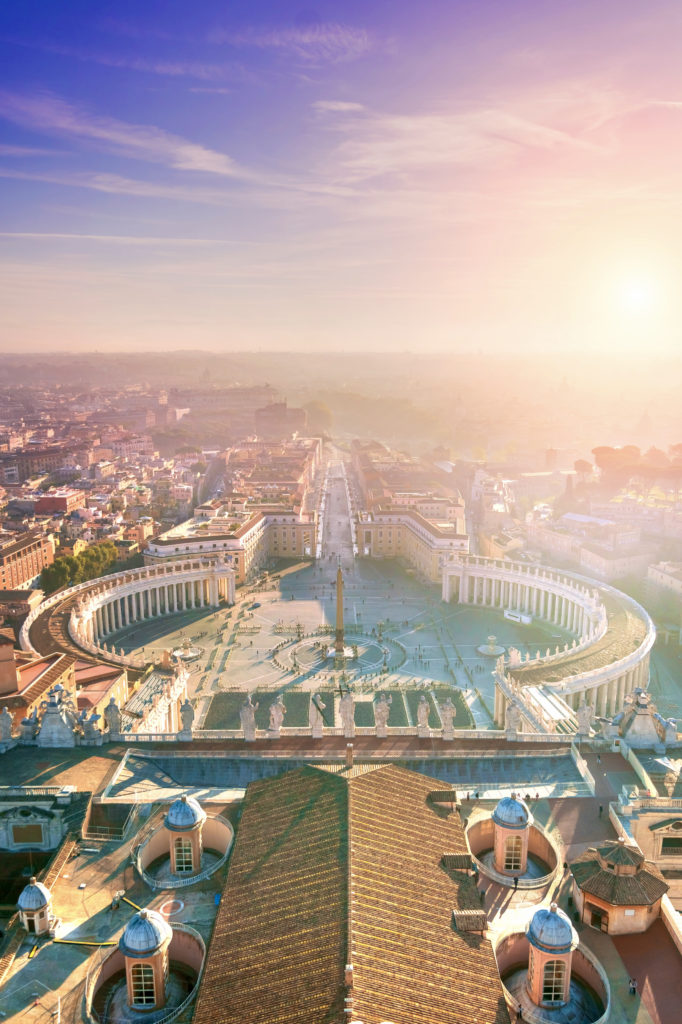
4. Vatican City
The Vatican isn’t just a walled city. It holds one of the world’s greatest art collections, housed in former wings of the Vatican Palace.
The Vatican Museums are one of the world’s most visited sites, attracting millions of visitors annually. The works in the Vatican are invaluable crowning glories of Western art.
A museum path leads you through the long corridors and wings of the Vatican Museums. Most of the fine art, as opposed to decorative art, is in the Vatican Pinacoteca (painting gallery), the Pio-Clementine Museum (sculpture gallery), the Raphael Rooms, the Borgia Apartments, and the Sistine Chapel.
Michelangelo’s Sistine Chapel frescos are the undisputed highlight of a visit to the Vatican. They’re among the most famous paintings in the history of art.
In 1533, Michelangelo made a return visit to the Sistine Chapel. Pope Julius II summoned him to paint The Last Judgment on the altar wall.
Click here to book skip the line tickets for the Vatican. This is essential if you don’t want to stand in line for hours. I also recommend this 3 hour no wait tour that also includes the Raphael Rooms.
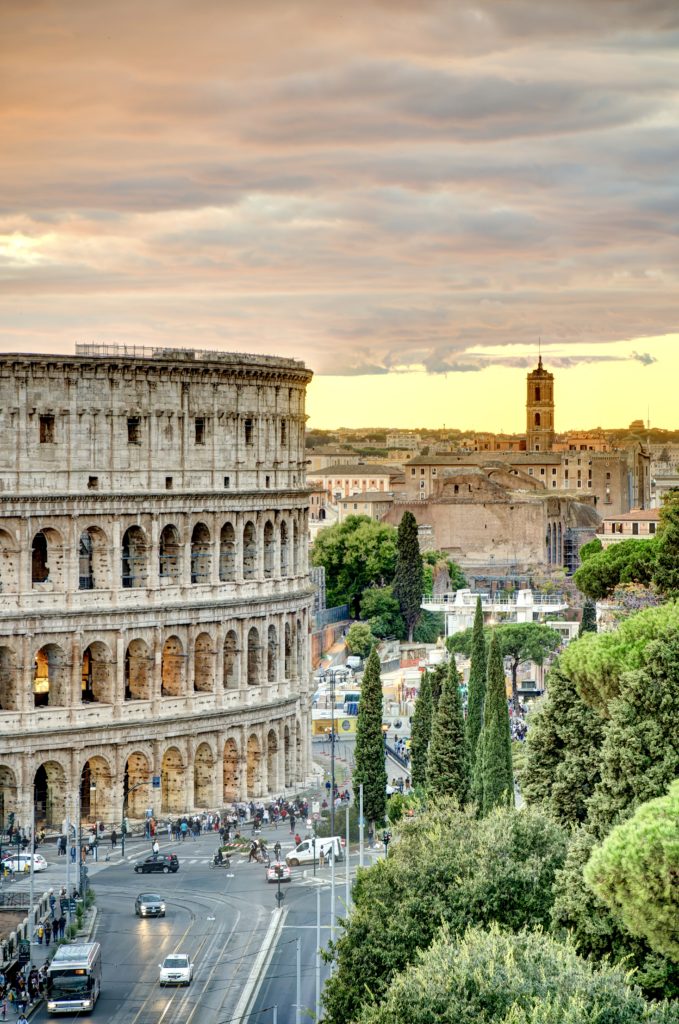
5. Colosseum
Formally named the Flavian Amphitheater, the Colosseum has stood in Rome for almost 2,000 years. It’s the most instantly recognizable landmark in Italy from the classical world. Despite the ravages of time, the Colosseum is an incredibly well-preserved piece of Rome’s fascinating history.
In its glory days, the Colosseum was a vivid white with painted trim and frescoed hallways. There were monumental statues of the Greek and Roman gods in the arches of the middle two stories. The top story had a retractable canvas awning to shade spectators.
The Colosseum hosted the popular “games,” a form of ancient theater re-creating far flung lands and mythological themes for the masses. There were many variations. The spectacles pitted men against men, men against beasts, and beasts against beasts.
Here’s my complete guide to the Colosseum. You may want to take a guided tour of the Colosseum or a tour that also includes the underground gladiator area of the Colosseum.
6. Castle Sant’Angelo
Castle Sant’Angelo is a 2,000 year old landmark in Rome. As a national museum, it’s official name is the Museo Nazionale di Castle Sant’Angelo. You might consider the distinctive round bulwark a sign that you’ve arrived at the Vatican.
In 139, Emperor Hadrian commissioned the castle’s construction as a mausoleum. Unlike Rome’s other famous archaeological sites, Castle Sant’Angelo never fell into ruins.
Instead, it continued to thrive and was repurposed. Castle Sant’Angelo was transformed from a tomb, to an impregnable fortress, to a prison, to a magnificent Renaissance papal residence, and finally to a museum.
Here’s my guide To Castle Sant’Angelo. Click here to pre-book a skip the line ticket.
7. Trevi Fountain
The Trevi Fountain is an imposing Baroque landmark in Italy, designed by architect Nicola Salvi. The fountain was immortalized in Fellini’s movie La Dolce Vita.
The fountain is 85 feet high and 65 feet wide, making it Rome’s largest fountain. In the center is the figure “Ocean.” Water pours from 24 spouts.
If you’re superstitious, toss a coin over your shoulder to ensure your return to Rome. Over 3,000 euros are collected from the fountain daily and donated to charity.
8. Piazza Navona
Piazza Navona is sometimes called the Square of Fountains. Dating from the 16th century, the beautiful Baroque square is the very symbol of Rome.
Piazza Navona is a long rectangle flanked by ochre colored buildings. The square is always filled with tourists, artists, and street vendors.
The square dates back to the time of Emperor Domitian in 86. He used it as a racetrack for chariot races and sporting matches. The buildings surrounded the piazza were once stadiums with screaming fans.
Beginning in 1652, Piazza Navona was turned into a lake in the summer. The drains of the fountains were closed and the square became flooded with water. Aristocrats would decorate their coaches like traditional gondolas. Sometimes there were mock naval battles.
9. Largo di Torre Argentina
The Largo di Torre Argentina is spot where Julius Caesar was assassinated on the Ides of March in 44 B.C. Caesar was assassinated by a conspiracy of senators.
They feared Caesar would crown himself king. The assassination was one of the most pivotal moments of the Roman Republic. It led to its downfall and the rise of the Roman Empire.
After a restoration funded by the fashion house Bulgari, the ruins of the Largo opened to the public in June 2023. Via walkways, you can visit four Republican era pagan temples and the ruins of the Theater of Pompey.
There’s also a fenced off feral Cat Sanctuary onsite. It’s protected and funded by an animal protection organization.
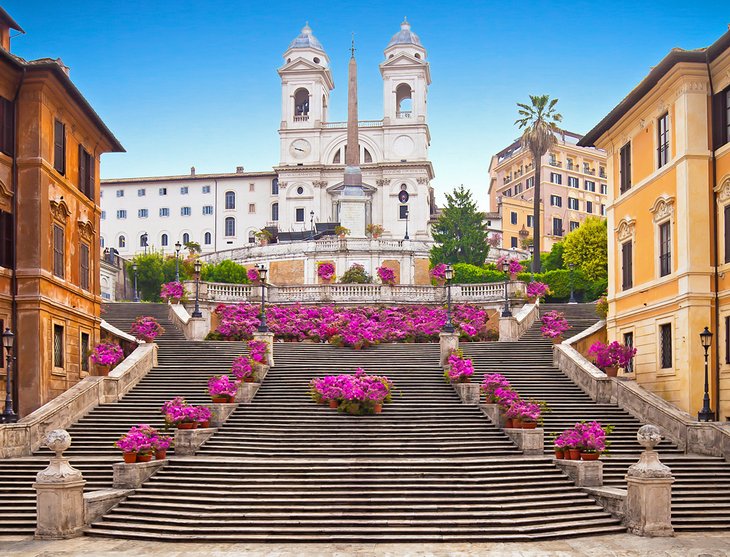
10. The Spanish Steps
The Spanish Steps are a beautiful set of steps and one of Italy’s most recognizable landmarks.
They climb a steep slope between the Piazza di Spagna at the base and Piazza Trinità dei Monti, dominated by the Trinità dei Monti church at the top.
As of 2019, you can no longer sit on the Spanish Steps. It’s classified as a national monument. Don’t sit down. If you’re caught sitting on the Spanish Steps, you risk paying a € 400 fine.
And, by the way, the Spanish Steps aren’t Spanish. They’re just named after the Spanish Embassy at the top of them.
11. Basilica of Santa Maria Maggiore
This beautiful basilica is a UNESCO-listed site in Rome’s Monti area. The basilica dates to the 5th century.
Santa Maria Maggiore is one of four papal basilicas in Rome and retains its original shape (with some embellishments). The basilica’s claim to fame is a perfectly preserved Byzantine interior. Beautiful 5th century mosaics decorate both sides of the nave. 13th century mosaics are in the apse.
The basilica also has a stunning coffered ceiling, sculpted by Giuliano da Sangallo in 1450. It’s covered in gold, brought back by Columbus. And there’s a famed relic, five pieces of Jesus’ manger crib downstairs in the Confessio.
Click here to book a guided tour of the beautiful basilica.
12. Ruins of Pompeii
Pompeii is Rome’s most famous archaeological site, a living museum. In 79 A.D., Mount Vesuvius erupted and buried the city in 60 feet of ash.
The ruins are a remarkable evocation of everyday Roman life. You can get a vicarious thrill sharing living space with ancient Romans.
In the complex, you’ll find roman baths, a roman forum, brothels, basilicas, a grand theater, and the oldest Roman amphitheater in the world.
Pompeii is the gift that keeps on giving. New finds are made all the time, including recently unveiled frescos. When you’re done exploring the ruins, head to a vineyard or restaurant on the nearby Mount Vesuvius.
It’s definitely easiest to visit on a guided day tour from Rome. But if you can get yourself there, you can then take a guided walking tour with an archaeologist to learn everything abut Pompeii. Or simply book a skip the line ticket.
READ: Ultimate Guide To Visiting Pompeii
13. Hadrian’s Villa, Tivoli
Hadrian’s Villa (Villa Adriana) is a UNESCO landmark in Italy in Tivoli. It’s the largest and most spectacular villa of ancient Rome, three times the size of Pompeii.
The villa is a testament to the power and glory of ancient Rome and the world’s most important leader, Emperor Hadrian. And it was designed by Hadrian himself, complete with its magnificent edifices, beautiful mosaics, and ancient statuary.
Hadrian’s sprawling complex is called a “villa.” But it’s more accurately a miniature Rome that covers nearly 300 acres. It’s dotted with 30 large structures — palaces, libraries, baths, living quarters, dining pavilions, and sculpture gardens.
Click here to pre-book a ticket. You can also visit Hadrian’s Villa on a guided day trip from Rome.
14. Villa d’Este, Tivoli
The UNESCO-listed Villa d’Este in Tivoli is a must visit landmark in Italy. The villa is the lush and watery country estate and gardens of a Catholic cardinal.
It makes the perfect day trip escape from Rome, just a half hour away. You can also combine it with a visit to Hadrian’s Villa.
The sumptuous late Renaissance estate is a playground of whimsy, topped with a frescoed villa. Built into a cliff, Villa d’Este’s terraced gardens are one of Europe’s most beautiful green spaces. There are waterfall fountains, ornate staircases, spiky cypress trees, and the gentle murmur of water everywhere.
The villa itself is a bit of an empty shell, with the furnishings and decor long gone. But most of the vibrant frescos and painted ceilings remain.
Set over 35,000 square meters, the verdant gardens will blow you away. You’ll see thundering fountains, placid pools, grottos, waterfalls, and natural beauty.
>>> Click here to book a ticket to Villa d’Este
15. Necropolis of Tarquinia
The UNESCO-listed Necropolis of Tarquinia is one of Italy’s most magnificent Etruscan sites. The “city of the dead” dates back to the 7th century B.C.
Since 1489, nearly 6,000 tombs have been excavated. The most important tombs are the Tomb of the Shields, the Tomb of the Lioness, and the Tomb of the Warrior.
There are 140 fantastic large scale wall frescos behind plexiglass. Press a button to light them up. The necropolis was popular with Roman artists. Raphael and Michelangelo ventured there to study the frescos.
Click here to book a guided tour of this must visit UNESCO landmark in Italy.
Landmarks In Northern Italy
16. Milan Cathedral, Milan
The Duomo is the nickname for Milan Cathedral, a renowned landmark in Milan Italy. The cathedral was built over 600 years beginning in 1368 and is a top attraction in Milan.
The Duomo is a flamboyant Gothic masterpiece with 135 marble spires. It’s the fourth largest church in the Europe, second in size in Italy only to St. Peter’s Basilica in Rome.
There’s plenty to admire — ornate statues, paintings, and the sarcophagi of famous Milanese citizens. In the transept, you’ll find the rather ghoulish statue of St. Bartholomew Skinned by Marco d’Agrate, a Leonardo student.
The Duomo’s truly spectacular and unmissable feature is its rooftop terrace. From the rooftop, you have an excellent view of the details of the cathedra’s intricate stonemasonry. You can see the panorama of the entire city before you, which is especially nice at sunset.
Click here to book a skip the line ticket with rooftop access.
17. Leonardo da Vinci’s The Last Supper at Santa Maria delle Grazie, Milan
Leonardo da Vinci’s The Last Supper is found on the back wall of the refectory in the monastery of Santa Maria delle Grazie in Milan. It was commissioned by Leonardo’s patron, Ludovico Sforza, the Duke of Milan.
No painting is so familiar, save for the Mona Lisa. In a swoosh of emotion, Leonardo captures each apostle’s unique reaction to his declaration — horror, astonishment, anger, anxiety, grief, shock, etc.
By the time Leonardo finished in 1498, the painting was already deteriorating. 20 years later, it was flaking off the wall. There have been seven documented attempts to repair The Last Supper, the most recent effort in the last 21 years.
You’ve got to be organized and reserve in advance to see this Leonardo masterpiece. Advance reservations are mandatory. Click here to book a ticket and tour, which may be your only option since tickets sell out months in advance.
18. Te Palace, Mantua
Te Palace is one of the world’s most unique and beautiful buildings., It’s a wildly inventive and theatrical feat of both architecture and decoration, a must visit landmark in Mantua Italy.
Te Palace was designed and built by Raphael’s best pupil, Giulio Romano, between 1525-35. It was the bling-y summer palace of the Gonzaga family.
The Hall of Cupid and Psyche is the palace’s most opulent room. It’s filled with racy frescos created by Raphael pupil, Giulio Romano.
The Hall of the Giants is also an extraordinary space. Every inch of the famous grotto-like hall is decorated with colossal scale figures. It’s almost an alternative Renaissance virtual reality.
Click here to book a walking tour of Mantua with entry to the Ducal Palace. Click here for a ticket + tour of the Ducal Palace.
19. Rocca Scaligera Castle, Sirmione
The beautiful town of Sirmione sits at the end of a narrow peninsula jutting into Lake Garda, the largest lake in northern Italy. Oleander, cypress, and palm trees mix into the foliage. And, rising against the town’s medieval skyline, is the enormous Rocca Scaligera, Sirmione’s unforgettable fortress.
The square cut castle was built in the 13th century by the Scaligera family of Verona.The castle is completely surrounded by a navigable moat. Impregnable walls and turrets rise from pale rustic stone.
Crenellated battlements wrapped in red top the fortress. The poet Dante is said to have stayed in the castle.
From the sweeping cobbled courtyard, steel staircases lead to the first turret and your first glimpse of panoramic views of the town. But you get the best views from scrambling up the 146 steps to the tallest tower.
Landmarks In Italy In Tuscany & Umbria
20. Duomo, Santa Maria del Fiore, Florence
Florence Cathedral is one of Italy’s most famous landmarks and the very symbol of Florence.
Florence’s Duomo is Gothic in styled made of brown sandstone and beautifully faced with pink, green, and white marble.
Filippo Brunelleschi’s magnificent terra cotta colored dome, built from 1420-36, is the highlight. It’s decorated with high Renaissance frescos by Giorgio Vasari, a Florentine artist and the world’s first art historian.
For panoramic views, climb up Brunelleschi’s dome. You can admire the Vasari frescos up close.
The Duomo is free to visit (though you’ll have to line up). You may want to book a guided tour of the Duomo with skip the line access.
You can also book a guided tour of the Duomo that includes access to the dome and secret terraces that you wouldn’t see on a regular visit. And it’s absolutely essential to pre-book a ticket to climb Brunelleschi’s dome.
21. Basilica of Santa Croce, Florence
The Basilica of Santa Croce is a must visit landmark in Italy for lovers of Renaissance art. The church dates from 1280. The ancient basilica has one of the greatest assemblages of frescos, painting, sculptures, and funeral tombs in the entire world.
The Santa Croce highlights are the frescos by Giotto in the Bardi Chapel and the Peruzzi Chapel. There are also frescos by his students Taddeo and Agnolo Gaddi. The ones by Agnolo are well preserved and have been recently renovated.
Santa Croce is also the resting place of storied Renaissance luminaries. You can find funeral tombs for Michelangelo, Ghiberti, Galileo, Dante, and Machiavelli.
Santa Croce also houses the famous Cimabue Crucifix. The artifact was damaged in a devastating flood in 1966, but has been somewhat restored.
Here’s my complete guide to the Basilica of Santa Croce Complex. Click here to buy a skip the line ticket. To see it all, click here for a guided tour.
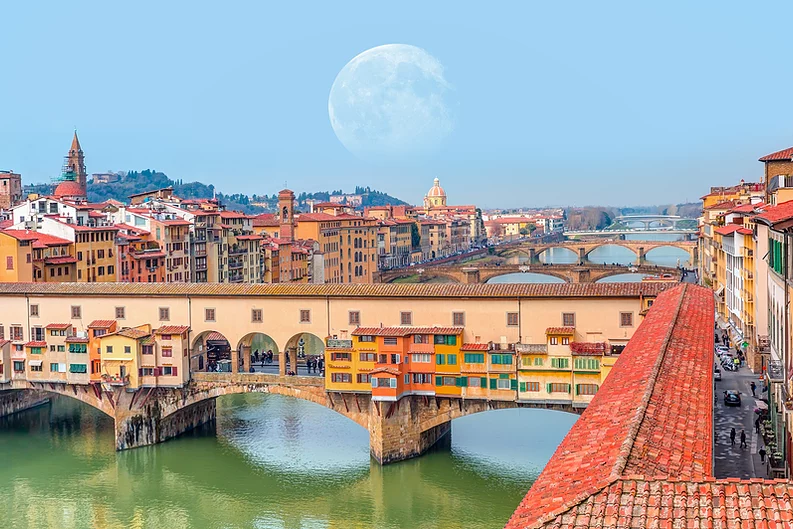
22. Ponte Vecchio, Florence
Dating from 1345, the Ponte Vecchio, or “old bridge,” is Florence’s only bridge to survive WWII. The Nazis destroyed all Florence’s other bridges.
The only reason Ponte Vecchio escaped unscathed is that Hitler had a soft spot for the bridge. Instead of destroying it, he destroyed the buildings at both ends.
The iconic Ponte Vecchio looks like houses suspended over the Arno River. It has three arches topped with a jumble of charming shops. In an urban setting, space was at a premium, so the bridge became a sort of mall.
Originally, the Ponte Vecchio housed unglamorous butcher shops. But the Medici family didn’t like escorting their aristocratic guests and diplomats over the bridge with the wafting stench.
So they swamped the butchers for goldsmiths. Now, you can buy expensive jewelry on the storied Ponte Vecchio.
23. Uffizi Gallery, Florence
Florence is synonymous with the Renaissance period of art history. The Uffizi is its premiere gallery, and the third most visited site in all of Italy. For art lovers, the Uffizi is a place of pilgrimage.
Some of the world’s most famous paintings are in the Uffizi — Botticelli’s Birth of Venus and Primavera, Titian’s Venus of Urbino, Leonardo da Vinci’s Annunciation, Caravaggio’s Medusa and Bacchus, Piero della Francesca’s unflattering portraits of the Duke and Duchess of Urbino, and Raphael’s Goldfinch Madonna.
The Uffizi consists of 45 halls of art spread over two floors of the palace. If you have limited time, you should focus your efforts.
The must see halls include the Hall 2 (Giotto), Hall 8 (Lippi), Hall 10-14 (Botticelli), Hall 15 (Leonardo), Hall 35 (Michelangelo), Hall 66 (Raphael), Hall 83 (Titian), and Hall 90 (Caravaggio).
Here’s my complete guide to the Uffizi Gallery, which includes must see masterpieces and tips and tricks for visiting. Click here to pre-book a timed entry ticket and click here for a guided tour.
24. Pitti Palace
The magnificent Palazzo Pitti is a stunning architecture gems and one of the best museums in Florence.
The palace’s most important museum is the magnificent Palatine Gallery. It houses an impressive collection of over 500 paintings, chock a block on top of each other amid lavish furnishings.
There are works by Raphael, Titian, Botticelli, Rubens, Caravaggio, Gentileschi, and other European and Italian painters. The ceilings are beautifully frescoed by Pietro da Cortona.
The Royal Apartments showcase styles from three different eras of ownership. You’ll find Baroque frescoed ceilings, gilded inlaid work, Rococo stucco, and red damask decorations.
Here’s my complete guide to the Pitti Palace. Click here to pre-book a ticket to the Pitti Palace. Click here to book a guided tour of the magnificent museum.
25. Palazzo Vecchio
Dating from the 13th century and steeped in history, the Palazzo Vecchio was Florence’s seat of power. It was the home of the City Council that governed the Republic of Florence and a residence of the Medici dynasty.
On the first floor of the palace is the stunning Michelozzo-designed courtyard. It’s decorated with fresco-filled loggias designed and painted by Giorgio Vasari.
The magnificent Hall of the Five Hundred is awash with more frescos by Vasari. On the second floor are the sumptuously decorated private rooms of the Medici, with recently restored frescos in the beautiful Apartment of the Elements.
Here’s my complete guide to the Palazzo Vecchio. Click here to pre-book an entrance ticket and audio guide. Click here for an entrance ticket + guided tour of the palace.
26. Palazzo Pubblico in Piazza del Campo, Siena
The magnificent Palazzo Pubblico sits proudly in one of Europe’s most beautiful medieval squares, the Piazza del Campo in Siena.
The palace was built in 1297-1308 for the Council of Nine, the governing body of the Republic of Siena. The facade is a harmonious example of early Renaissance architecture, an elegant and symmetrical backdrop to the famed piazza.
Inside, in the Hall of the Grand Council, you’ll one of Italy’s most precious paintings, Simone Martini’s Maesta. The Hall of Peace has an amazing cycle fresco, Ambrogio Lorenzetti’s Allegory of Good and Bad Government.
Beside the Gothic palace soars the slender Tower of Mangia, which you can climb for panoramic views.
Here’s my complete guide to visiting Palazzo Pubblico. Click here to book a tour of this magnificent landmark in Italy.
27. Siena Cathedral, Siena
Siena Cathedral is a beautiful Gothic landmark in Italy. Siena Cathedral is one of Europe’s most beautiful churches. I’s clad all over in Siena’s trademark white and dark green marble. Consistent with the Gothic ethos that “more is always better,” every inch is decorated with marble, mosaics, sculptures, and frescos.
Visiting Siena’s Duomo complex is akin to going to an art museum. It’s filled with mind blowing art from some of the greatest artists of the Gothic and early Renaissance periods, including Donatello, Pisano, Pinturicchio, and Michelangelo.
The Duomo complex consists of six must see structures: the cathedral itself, the Piccolomini Library, the Baptistry, the cathedral museum (Museo dell’Opera del Duomo), the Crypt, and the Facciatone viewing terrace.
To visit the amazing Siena Duomo complex properly, you need to pre-purchase the Opa Si Pass.
28. Towers of San Gimignano
Nicknamed the “Medieval Manhattan,” the turreted hill town of San Gimignano is one of Italy’s most beautiful towns. It boasts a startling cityscape of 14 spiky towers poking the sky.
The towers are one of Italy’s most iconic landmarks. The most famous tower is the Torre Grossa. Climbing to the top is a must do in San Gimignano.
Not surprisingly, San Gimignano’s historic center is a UNESCO site.
The central square is the Piazza del Duomo. There, you’ll find the Collegiate Church of Saint Mary of the Assumption. Consecrated in 1148, it’s a beautiful (mostly) Romanesque church, austere on the outside with a feast of frescos on the inside.
Here’s my complete guide to the top attractions in San Gimignano. Click here for a walking tour of the town.
29. Piazza della Signoria
The Piazza della Signorina is Florence’s most famous square. It’s the center of Florentine life and politics, a meeting spot buzzing with activity.
The piazza is the jackpot of outdoor street art. Many beautiful sculptures by Italy’s greatest artists are on display in front of the Palazzo Vecchio or adjacent to it in the Loggia dei Lanza.
Each statue in the Piazza della Signoria represents a different chapter in Florence’s long history. The statues tell stories of murder, rape, religion, mythology, and key moments in art history.
Here’s my complete guide to the sculptures of the Piazza della Signoria.
30. Basilica of St. Francis, Assisi
Located in Umbria, Assisi was the home and final resting place of St. Francis. and is a pilgrimage destination. The 13th century Basilica of St. Francis of Assisi is one of Italy’s best known churches and a landmark UNESCO site.
There are two parts to the church — the lower church (for pilgrims) and the upper church (for clergy). The frescos in the lower church mark the pivotal transition in art history from the Gothic period to the early Renaissance era.
The highlight are Giotto’s frescos in the Chapel of Santa Maria Maddalena. That chapel also has a fresco cycle by Pietro Lorenzetti, with a haunting Depostion.
The upper church houses paintings by Cimabue, the greatest Italian painter of the 13th century International Gothic style. Giotto, who was Cimabue’s protege, also reputedly painted a 28 panel cycle called The Life of St. Francis, between 1297 and 1300. It’s worth noting, however, that some scholars dispute the Giotto attribution.
Here’s my complete guide to the Basilica of St. Francis of Assisi. Click here to book a walking tour of Assisi with a guided tour of the basilica.
31. Field of Miracles, Pisa
The UNESCO-listed Field of Miracles is one of Italy’s most famous landmarks. It’s a true spectacle — a simply splendid assemblage of Romanesque, Gothic, and Early Renaissance art and architecture.
When you clap eyes on its marble sheathed buildings, you’ll likely gasp and conclude that it deserves the hype. Here are the six must see sites on the splendid square:
- The Leaning Tower
- The Duomo di Pisa
- The Baptistery
- The Monumental Cemetery
- Duomo Museum
- Museum of Sinopie
Although a tourist-fly draw, the Leaning Tower is the least interesting of the monuments. For more information, here’s my guide to all the attractions in Pisa.
Click here for a guided tour of Pisa’s landmarks and the Leaning Tower. Click here to pre-book a skip the ticket for the Leaning Tower.
32. Orvieto Cathedral, Orvieto
Medieval Orvieto is a popular day trip from Rome. The hilltop town’s piece de resistance is its magnificent cathedral, a marvel of theatricality.
Begun in 1290, Orvieto Cathedral is a riveting ensemble of spires, spikes, golden mosaics, statuary, stained glass, and black and white striped marble. And that’s just the facade.
Inside, the Chapel of San Brizio boasts one of the Renaissance’s greatest fresco cycles by Luca Signorelli. The frescos depict the usual religious themes — temptation, damnation, and salvation.
In the cathedral museum around the corner, you can inspect 2,000 works of art preserved from the church. The best works are by Andrea Pisano and Francesco Mocchi.
Click here to book a walking tour of Orvieto and Orvieto Cathedral.
Landmarks In The Veneto Region Of Italy
33. Rialto Bridge, Venice
The iconic Rialto Bridge is another one of the Italy’s most famous landmarks. It connects the sestieres (neighborhoods) of San Marco and San Polo. There was first a bridge located here in 1181. There’s been a bridge here for most of Venice’s history.
Space was an important urban commodity. So the Venetians didn’t leave the bridge space unexploited. In 15th century, shops were added to the bridge, inspired by the Ponte Vecchio in Florence.
The present Rialto Bridge was built between 1588-91 by an obscure architect named Antonio de Ponte. He even beat out Michelangelo, who also submitted a design for the competition.
READ: The History of Venice in a Nutshell
34. St. Mark’s Basilica, Venice
St. Mark’s is an astonishing tour de force of Italo-Byzantine architecture. Consecrated in 1093, it’s one of the world’s most famous churches.
St. Mark’s was built to house the relics of the evangelist St. Mark. The church’s footprint is a Greek cross plan, with a giant dome above the crossing point. Each of the four arms is also surmounted with a dome.
Inside, is a golden extravaganza of mosaics, 90,000 square feet in total. The oldest mosaics in St. Mark’s date back to 1070, telling Old Testament stories.
The baldachin, or architectural shelter, marks the spot where the body of St. Mark rests in the crypt below. Behind the baldachin is the Pala d’Oro, an exquisite Byzantine golden altarpiece. It’s a massive bejeweled screen.
Click here for a guided tour of the magnificent basilica. Click here for a tour that includes both the Doge’s Palace and St. Mark’s Basilica.
READ: Complete Guide To St. Mark’s Basilica
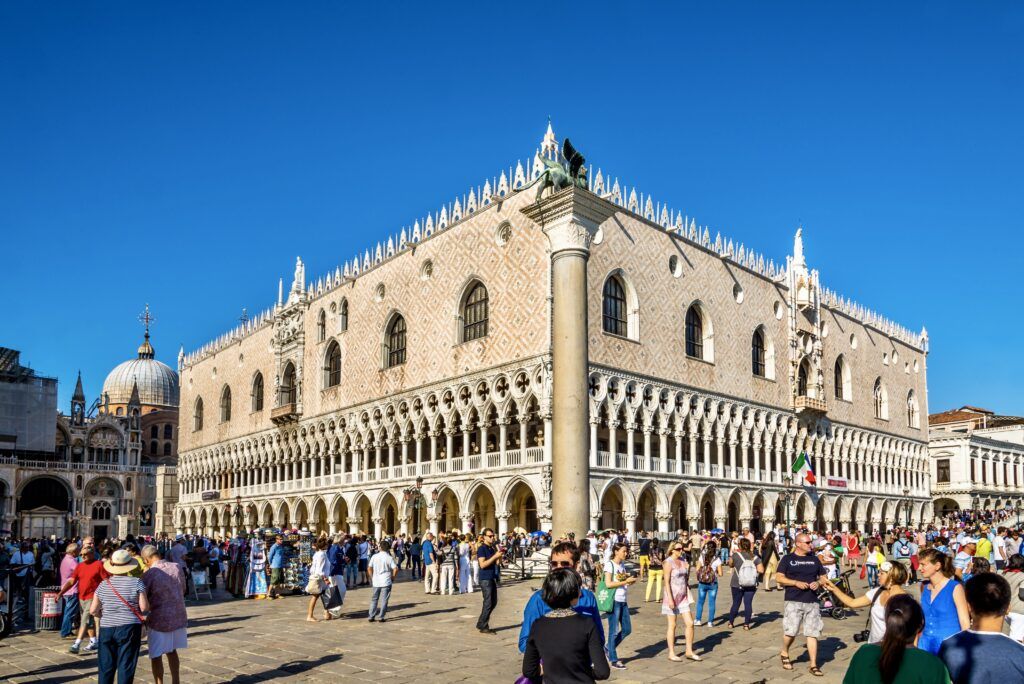
35. Doge’s Palace, Venice
The Doge’s Palace stands as a remarkable fusion of architectural styles —Venetian Gothic, Byzantine, and Renaissance. Through the centuries, it was not only the political center of the Republic of Venice but also the residence of its elected leader, the Doge.
Behind its charming pink façade, the palace bore witness to the exercise of power and displays of authority.Within these walls, opulence intertwined with governance.
Lavish decorations and grand proportions aimed to inspire awe and demand reverence. The era’s foremost artists adorned vast expanses of walls, making the palace an artistic masterpiece. Among the must see highlights are the awe-inspiring Golden Staircase and Tintoretto’s monumental masterpiece, Il Paradiso, the world’s largest painting.
If you take the VIP secret itineraries tour, you can cross the fabled Bridge of Sighs and delve into the dungeons where prisoners once faced interrogation and torment.
Here’s my complete guide to the Doge’s Palace. You should definitely pre-book skip the line reserved entry ticket.
36. Grand Canal, Venice
Cruising the historic Grand Canal in Venice is a classic, unmissable thing to do in Italy. As you sail, you can admire Venice’s must see sites and dreamy palazzos. The Grand Canal isn’t man made. It follows the path of an ancient river bed underneath.
During Venice’s heyday, the Grand Canal was used by traders, making their way to the Rialto Bridge. Today, it’s flanked with over 170 buildings — including pastel mansions, gleaming Byzantine palazzi, and Venice’s finest museums.
The most important buildings on the Grand Canal were residences of Venice’s powerful patrician families. Because of these sumptuous palaces, the Grand Canal has been described “as the most beautiful street in the world.”
Click here for a 1 hour boat tour of the Grand Canal. Click here for a 2 hour boat tour that includes secret canals. For a special splurge, go on a private gondola tour.
37. Roman Arena, Verona
Verona is a beautiful peach colored town in northern Italy, an easy day trip from Venice. Its key landmark is the majestic Roman Arena, the Arena di Verona, in the Piazza Bra. Click here to book a skip the line ticket and tour.
It’s the third largest classical arena in Italy, after Rome’s Colosseum and Capua’s Colosseum. And one of Italy’s best preserved Roman monuments.
Built in A.D. 30, the open air amphitheater first served as a stage for brutal gladiatorial games, jousts, circuses, and tournaments. It originally seated 30,000 people.
The arena is still in use today. But instead of gory fight, you can watch large scale opera performances, benefitting from the wonderful acoustics of its elliptical shape.
>>> Click here to pre-book a skip the line ticket
38. Scrovegni Chapel, Padua
Padua is a pretty university town just an hour from Venice. It boasts one of the greatest treasures in Western art, the UNESCO-listed Scrovegni Chapel, also known as the Arena chapel.
Wallpapered with exquisite frescos by Giotto, the Scrovegni Chapel is a precious masterpiece of Italian art. Giotto painted a cycle of 39 frescos depicting the lives of Mary and Jesus in 1303-05. It’s definitely as stunning in person as the Sistine Chapel in the Vatican Museums.
Giotto was the greatest painter of the 14th century. His Scrovegni frescos were a watershed moment in art history. With their naturalism, the chapel is considered one of the first examples of “modern art” and profoundly influenced subsequent Renaissance painters.
Here’s my complete guide to Giotto’s Scrovegni Chapel. Click here to book a guided tour of this magnificent Italian landmark that also takes you to St. Anthony’s Basilica.
39. Basilica of San Vitale, Ravenna
Ravenna is a glittering jewel box of 5th and 6th century mosaic art. Ravenna was once the epicenter of the Western World, when the Byzantine Empire made Ravenna its capitol.
The Byzantine rulers decorated Ravenna’s churches with gorgeous mosaics. This artistic legacy rivals, or even surpasses, that of Venice and Istanbul. Ravenna has a whopping 8 UNESCO sites to explore.
Finished in 547 and almost 1500 years old, the Basilica of San Vitale is Ravenna’s masterpiece. It boasts dazzling Byzantine mosaics in the presbytery and choir, meant to evoke a heavenly realm. In the apse above the altar, there’s a mosaic depicting Christ the Redeemer.
Just below is Ravenna’s pièce de résistance — two famous panels dedicated to the Emperor Justinian and his wife Theodora. They show the pair making offerings to Jesus against a field of gold. They are both resplendent in fine capes and jewels, proving to the world that they’re back in charge.
Here’s my complete cuide to Ravenna’s Mosaics. Click here to book a guided walking tour of the mosaics.
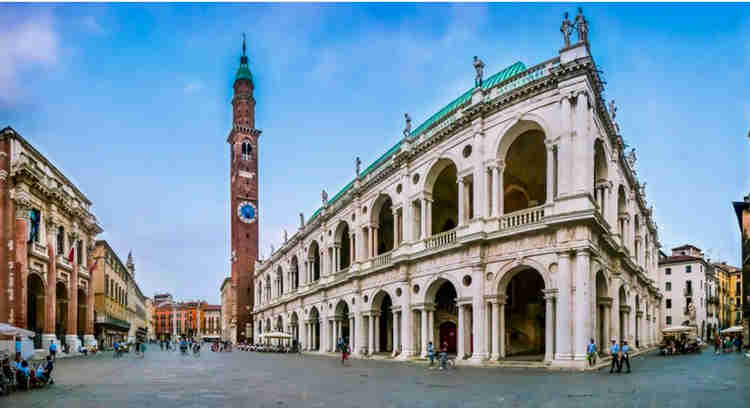
40. Palladian Architecture of Vicenza
Vicenza is especially renowned as the crucible for the celebrated architect Andrea Palladio. In 1994, the entire city of Vicenza became a designated UNESCO World Heritage Site specifically to protect Palladio’s palazzi and villas.
The two most famous Palladian landmarks are the Basilica Palladiana and the Olympic Theater.
The Basilica Palladiana is a regal 16th century church. Its facade has a stately double row of marble columns, which march gracefully down the piazza. The basilica boasts one of Palladio’s greatest inventions, known today as the “Palladian Window.”
The Olympic Theater is one of only three Renaissance theaters still standing in Italy. The theater recreates an ancient Roman amphitheater as an indoor Renaissance playhouse.
Here’s my complete guide to the top attractions in Vicenza. Click here to book a guide walking tour of all the Palladio monuments.
Landmarks In Southern Italy
41. Royal Place of Caserta, Naples
The incredible Palace of Caserta is a UNESCO- listed landmark in Naples Italy. Built by King Charles VII of the House of Bourbon, it was used as the main residence of the kings of Naples. With over 1200 rooms, the palace was one of the largest palaces in 18th century Europe.
The sprawling palace complex was built on a grid with four outer wings. You enter via the Grand Staircase of Honor, surrounded by marble.
The palace is lavish inside, especially the gold filled throne room. Caserta Palace comes complete with stunningly beautiful gardens, with long reflecting pools and statuary.
Click here to book a skip the line entrance ticket and click here for a guided tour of the palace.
READ: 3 Days in Naples Itinerary
42. Trulli of Alberobello, Puglia
The Trulli district in Alberobello looks like a fairytale stage set. It’s an icon of the Puglia region. You can get a real feel for old time-y Italy.
Trulli are whitewashed dry stone huts with conical roofs. They’re sprinkled over the farms and fields in Puglia. In Alberobello, there are over 1600 tiny trulli, earning UNESCO status for their hobbit-like uniqueness.
Most of the the trulli date from the 14th to 19th centuries. They proliferated in this area because they were easy to build, with stones stacked in place without mortar in prehistoric fashion.
There are two main trulli zones in Alberobello — Rione Monte (well known) and Rione Ria Piccola (less touristy). The most celebrated trulli in town is the Trullo Sovrano in Piazza Sacramento.
For more information, here’s my one day in Alberobello itinerary. Click here for a 2 hour walking tour of Alberobello.
43. Valley of the Temples, Agrigento Sicily
The Valley of the Temples is the world’s largest archaeological site and Sicily’s star attraction. Lying on the island’s southern coast, the complex is chock full of spectacular Greek ruins, making it one of Italy’s most famous landmarks.
In the eastern zone, you’ll find the best preserved temples — the Temple of Hercules, Temple of Concord, and the Temple of Juno. The Temple of Hercules is the oldest.
The western zone was the intended locale for the largest temple of the Greek world, the Temple of Zeus. But it was toppled by an earthquake. One remaining treasure, a 26 foot statue of a telamon (stone giant)) is the prize possession of the Museum of Archaeology.
In high season, you should pre-book a skip the line ticket to avoid lines. You can book a guided tour from Catania or a guided tour from Palermo.
44. Greek Theater, Taormina Sicily
Sicily’s Taormina is an over-the-top beautiful town with a surfeit of star quality. It’s premiere attraction and must visit landmark in Italy is the impossibly romantic ancient Greek Theater (Teatro Greco).
It’s carved out of a rock and perched on a hilltop. Building began ages ago, in the 3rd century B.C.
With the backdrop of Mount Etna and the Ionian Sea, the theater has one of Italy’s most theatrical settings. The view is unbeatable.
After the Greeks plied their trade, Romans did some rebuilding, adding the finishing touches to the 2nd century B.C. edifice. Like the arenas in Rome and Verona, the Taormina theater was used for gladiatorial escapades.
Nowadays, though in picturesque ruin, the theater is used for performances, opera, and film screenings. Follow the Corso Umberto, Taormina’s main pedestrianized lane, until you see signs for the site. It’s a beguiling snapshot of ancient history.
Click here to book a walking tour that includes the Greek Theater. For more information, check out my one day in Taormina itinerary.
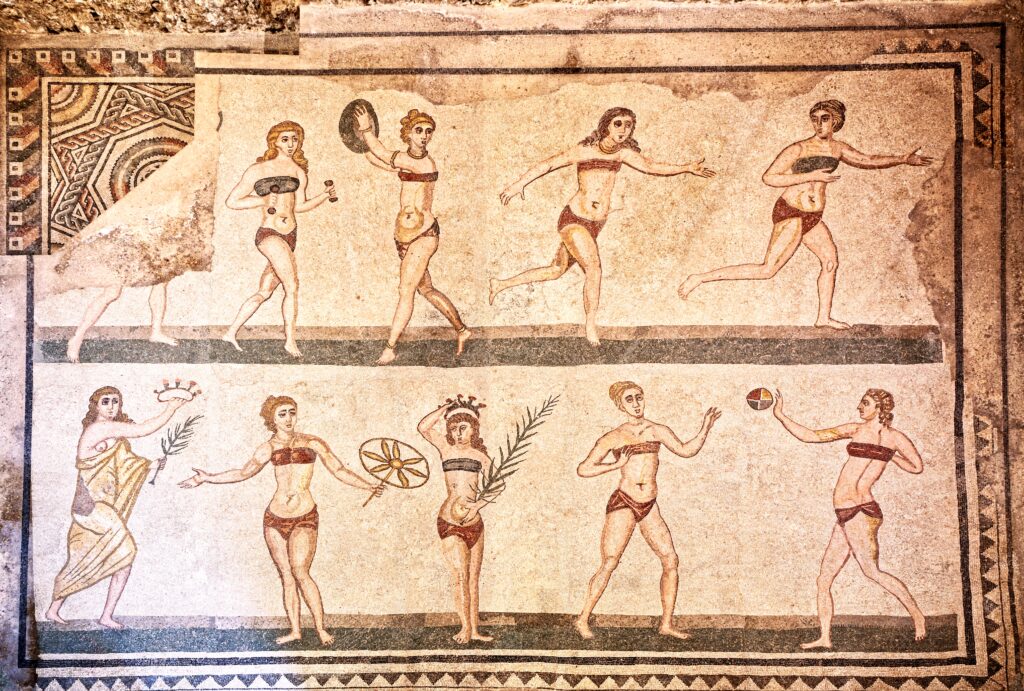
45. Villa Romana del Casale, Sicily
Villa Romana del Casale in Sicily is an incredibly mosaicked country villa built by Roman aristocrats in the 4th century. Tucked away in a remote area of central Sicily, this UNESCO site and landmark in Italy is a bit of a hidden gem.
Villa Romana del Casale has the world’s largest collection of in situ Roman mosaics — 3,700 square feet. They’re well-preserved and truly incredible, some of the most whimsical and detailed mosaics from the ancient world I’ve seen.
The time capsule villa gives you an “up close and personal” look at just how extravagantly aristocratic Romans once lived.
You can visit the villa on a guided tour from Catania, from Agrigento, from Palermo, or from Taormina.
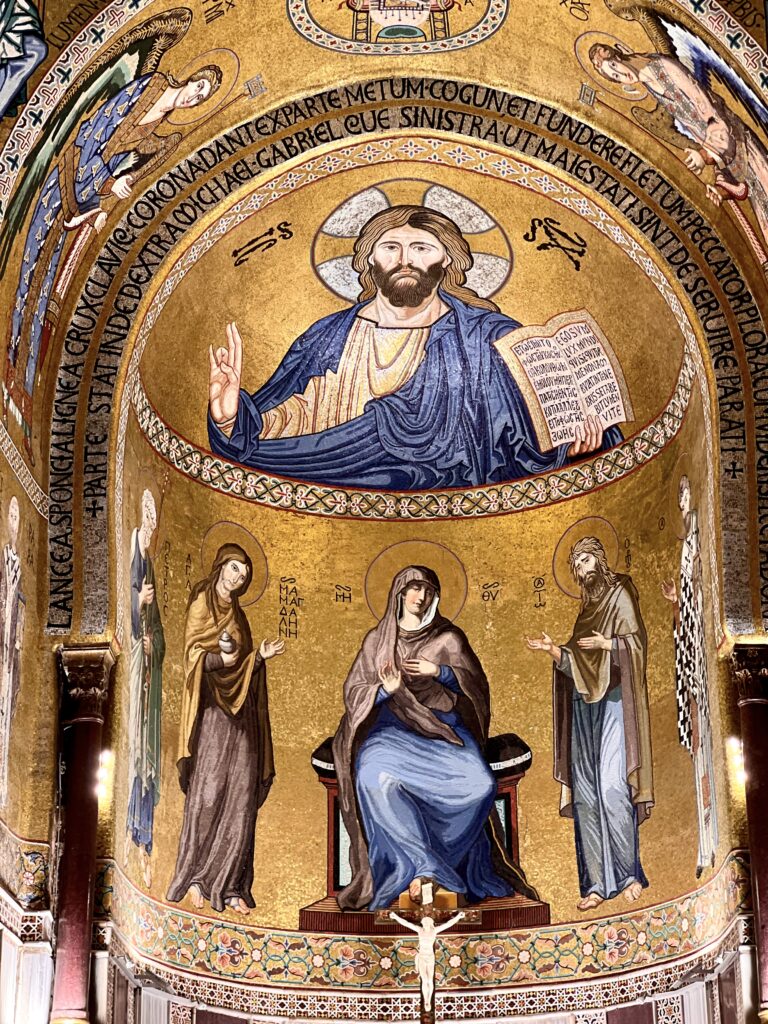
46. The Palatine Chapel, Sicily
The Palatine Chapel is the top attraction in Palermo and a UNESCO listed landmark in Italy.
It’s an extraordinary space filled with glittering Byzantine style mosaics. French author Guy de Maupassant once described the chapel as “the finest religious jewel dreamed up by the human mind.”
It was built by King Roger II, who spared no expense. He hired mosaicists from Constantinople to fill the walls with breathtaking Byzantine style mosaics. The most famous mosaic is the massive Christ Pantocrater.
You can also admire a 12th century muqarnas style ceiling and lavish marble floors.
I strongly suggest booking a skip the line ticket in advance on the palace website. You may want to book a guided tour because there’s almost no signage and no audio guide.
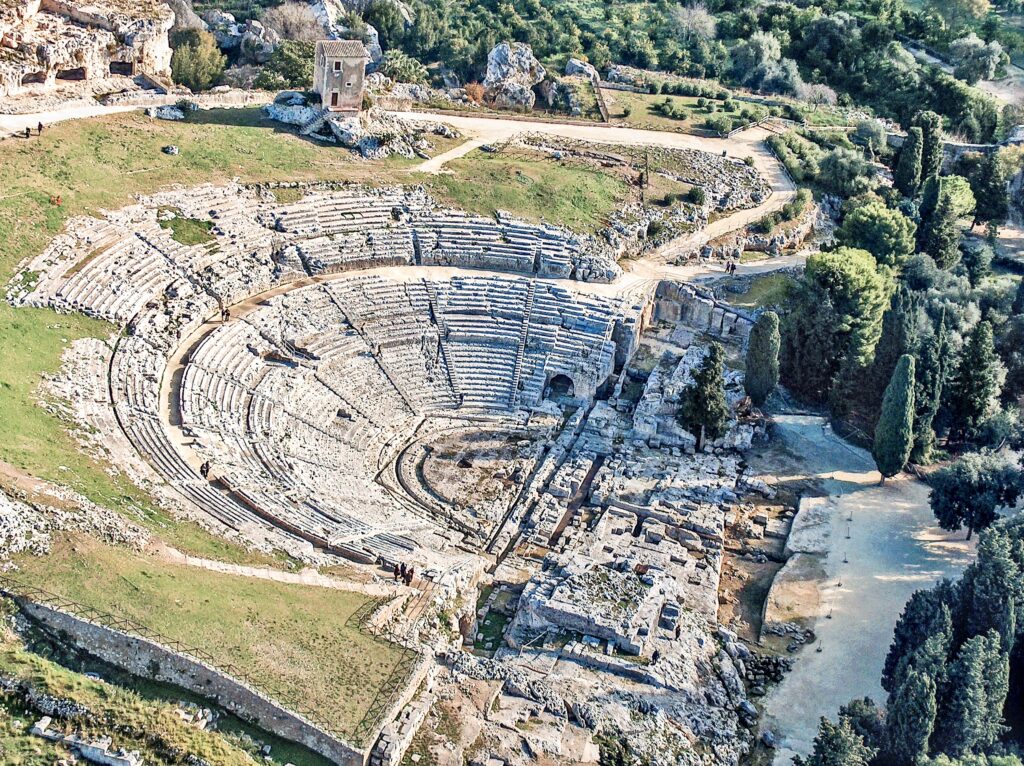
47. Neapolis Archaeological Park, Sicily
Neapolis Archaeological Park is located in the beautiful city of Syracuse Sicily, which was once of the most beautiful Greek cities in the Mediterranean.
Its UNESCO-listed park complex features one of the largest and most impressive Greek theaters in existence, as well as an elliptical Roman arena and mysterious grottos.
The park is fairly large and you may want to plan what you want to see in advance. The park has recommended 45 minute, 1 hour, and 90 minute routes.
Here’s my complete guide to visiting Syracuse’s Archaeological Park. You should book a skip the line ticket in high season. I also recommend booking a guided tour to help make the ruins come to life.
48. Castle del Monte, Puglia
Looking straight out of an Arthurian legend, the Castel del Monte is a symbol of Puglia and famous landmark in Italy. It’s an octagonal shaped castle built by the Holy Roman Emperor Frederick II in the 13th century.
This Puglia creation is a mysterious fortress-like building set high, like a crown, on a middle-of-nowhere plateau in Puglia.
In 1996, it became a designated UNESCO site, for its architectural harmony and mathematical and astronomical features. The original function of the structure is still unclear. It’s not exactly a castle, not exactly a fortress, not exactly a palace.
Each of the castle’s eight corners sports a tower. The castle has a blend of architectural elements –medieval, Islamic, classical antiquity. Inside, two floors overlook an internal courtyard and trapezoidal rooms, with spiral staircases linking the floors.
>>> Click here to book a ticket & tour for Castel del Monte
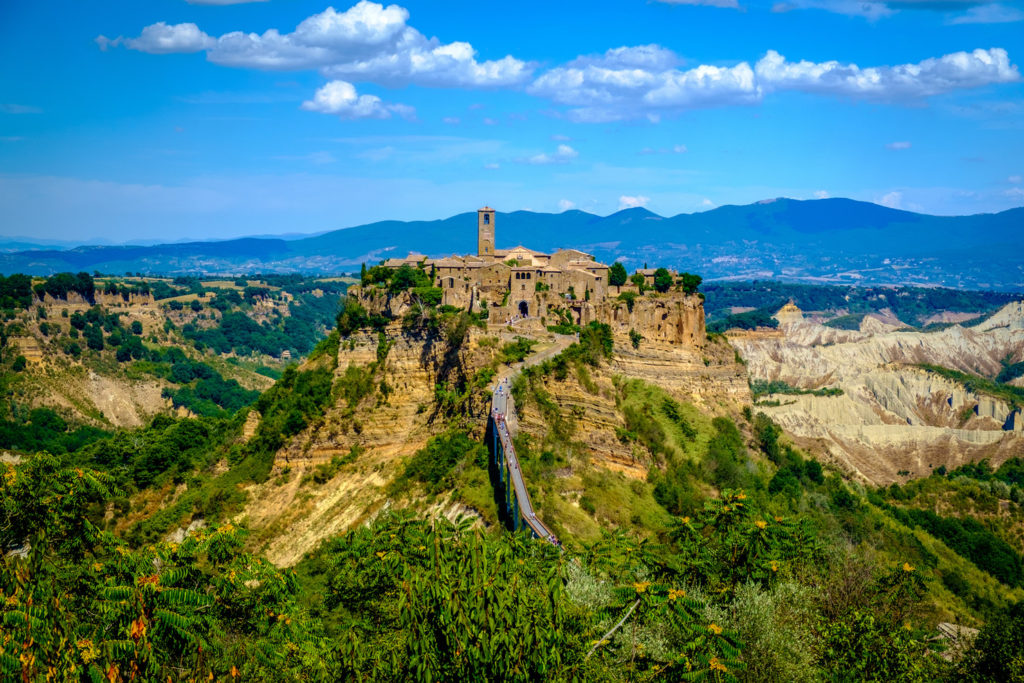
49. Civita di Bagnoregio, Viterbo
The Etruscans founded Civita di Bagnoregio over 2500 years ago and it’s largely unaltered ever since. The isolated and picturesque Civita teeters on a hilltop in a vast canyon, north of Rome. The topography scares away most tourists.
To access this little hamlet, you’ll have to ditch your car, walk across an elevated and steep 300 meter pedestrian bridge, and enter via a massive 12th century stone arch called the Porta Santa Maria. What could be more dreamy and surreal?
Once inside, the charms of Civita are subtle. There’s nothing special to do but look around in this rural village. It’s just unadulterated old world Italy. The warm stone walls glow in the sunshine. Have a seat on the steps of San Donato Church, be suspended in time, and admire the flowerpots.
Click here to book a combined tour of Civita and Orvieto.
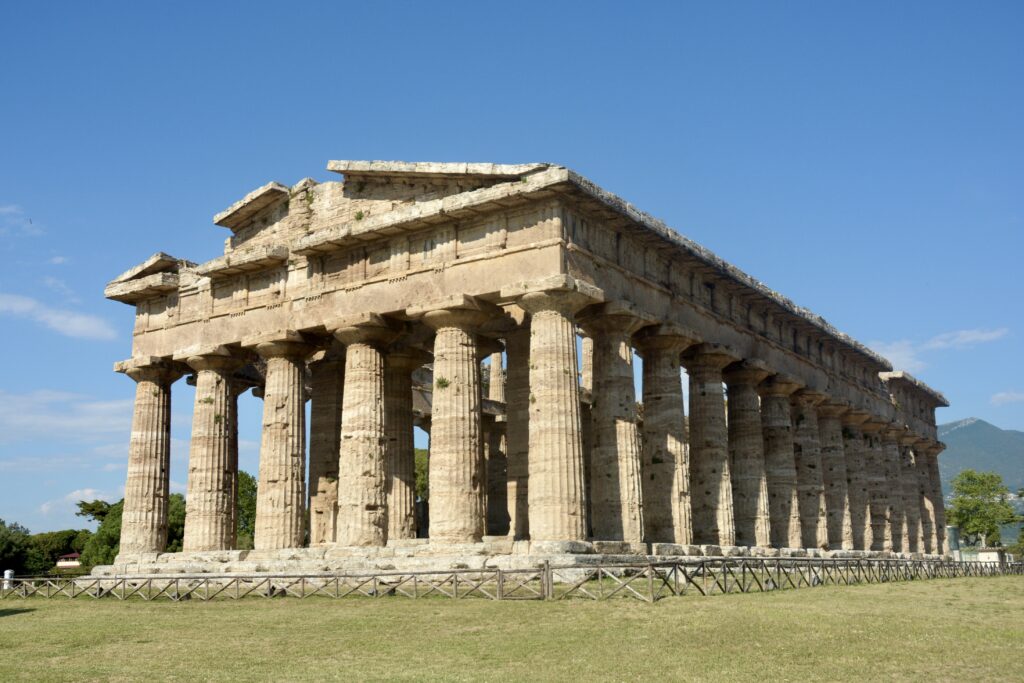
50. Greek Ruins of Paestum, Paestum
Nestled just south of the renowned Amalfi Coast is the captivating town of Paestum, a living testament to Italy’s ancient heritage. A designated UNESCO site, Paestum is a true trove of mesmerizing Greek archaeological wonders, unrivaled on the Italian mainland.
This town once played a pivotal role in Magna Graecia, or Greater Greece, It boasts three remarkably preserved Doric temples dating back to 650 to 450 BC. These monumental structures stand alongside an amphitheater, forum, well-preserved houses, and ancient pathways, all offering a glimpse into the past.
At the heart of Paestum, an archaeological museum brings the past to life. It houses a rich collection of archaeological discoveries spanning centuries of excavation at the Paestum site. Its sections delve into Paestum’s prehistoric origins, the intricate tapestry of the Lucanian civilization, the vibrant era of Greek Paestum, and the echoes of Roman influence.
Here’s my complete guide to visiting Paestum.
>>> Click here to pre-book a Paestum ticket
I hope you’ve enjoyed my guide to the 45 must visit landmarks in Italy. Need more of Italy? You may enjoy these guides and resources:
- 100+ Bucket List Ideas For Italy
- 7 Ways To Spend 1 Week in Italy
- 10 Day Itinerary for Italy
- 10 Day Itinerary for Tuscany
- 30 Most Beautiful Towns in Italy
- One Week Amalfi Coast Itinerary
- One Week in Umbria Itinerary
- Tips for Visiting Italy
- 3 Days in Rome Itinerary
- Hidden Gems in Rome
- 3 Days in Florence Itinerary
If you’d like to visit famous landmarks in Italy, pin it for later.

